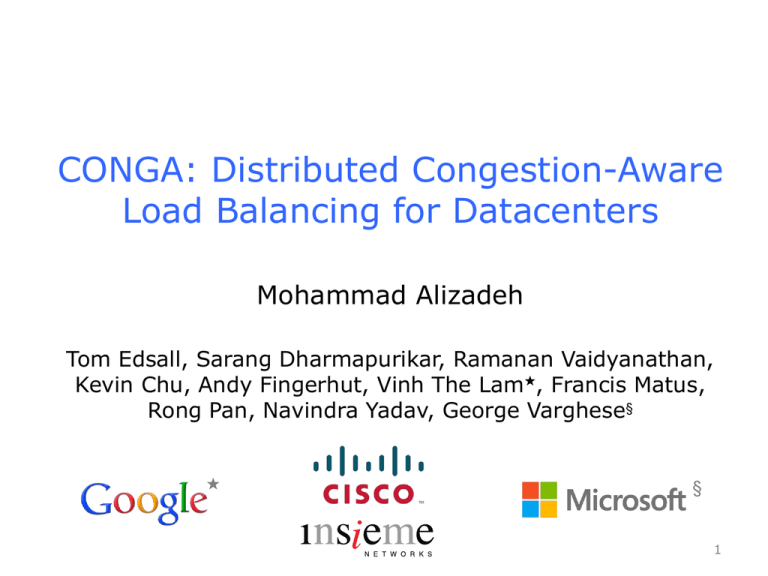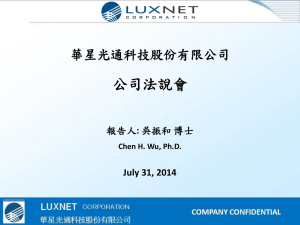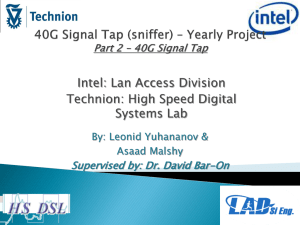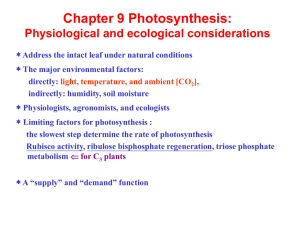Slide
advertisement

CONGA: Distributed Congestion-Aware Load Balancing for Datacenters Mohammad Alizadeh Tom Edsall, Sarang Dharmapurikar, Ramanan Vaidyanathan, Kevin Chu, Andy Fingerhut, Vinh The Lam★, Francis Matus, Rong Pan, Navindra Yadav, George Varghese§ ★ § 1 Motivation DC networks need large bisection bandwidth for distributed apps (big data, HPC, web services, etc) Multi-rooted tree Single-rooted tree[Fat-tree, Leaf-Spine, …] Core Full bisection bandwidth, achieved via multipathing High oversubscription Spine Agg Leaf Access 1000s of server ports 2 Motivation DC networks need large bisection bandwidth for distributed apps (big data, HPC, web services, etc) Multi-rooted tree [Fat-tree, Leaf-Spine, …] Full bisection bandwidth, achieved via multipathing Spine Leaf 1000s of server ports 3 Multi-rooted != Ideal DC Network Ideal DC network: Big output-queued switch Can’t build it Multi-rooted tree ≈ 1000s of server ports 1000s of server ports No internal bottlenecks predictable Simplifies BW management Possible Need precise balancing bottlenecks [EyeQ, FairCloud, pFabric, Varys,load …] 4 Today: ECMP Load Balancing Pick among equal-cost paths by a hash of 5-tuple Approximates Valiant load balancing Preserves packet order Problems: - Hash collisions (coarse granularity) - Local & stateless H(f) % 3 = 0 (v. bad with asymmetry due to link failures) 5 Dealing with Asymmetry Handling asymmetry needs non-local knowledge 40G 40G 40G 40G 40G 40G 6 Dealing with Asymmetry Handling asymmetry needs non-local knowledge Scheme 30G (UDP) 40G ECMP (Local Stateless) Local Cong-Aware 30G 40G 40G 40G (TCP) Thrput Global CongAware 40G 40G 7 Dealing with Asymmetry: ECMP 30G (UDP) 40G 30G 40G Scheme Thrput ECMP (Local Stateless) Local Cong-Aware 60G Global CongAware 10G 20G 40G 40G (TCP) 40G 40G 20G 8 Dealing with Asymmetry: Local Congestion-Aware 30G (UDP) 40G 30G 40G Scheme Thrput ECMP (Local Stateless) Local Cong-Aware 60G 50G Global CongAware 10G 40G 40G (TCP) 40G 40G 20G 10G Interacts poorly with TCP’s control loop 9 Dealing with Asymmetry: Global Congestion-Aware 30G (UDP) 40G 30G 40G Scheme Thrput ECMP (Local Stateless) Local Cong-Aware 60G Global CongAware 70G 50G 10G 5G Global CA > ECMP > Local CA 40G 40G 40G (TCP) 35G 10G 40G Local congestion-awareness can be worse than ECMP 10 Global Congestion-Awareness (in Datacenters) Datacenter Opportunity Challenge Latency microseconds Topology Simple & Stable simple, regular Traffic volatile, bursty Responsive Key Insight: Use extremely fast, low latency distributed control 11 CONGA in 1 Slide 1. Leaf switches (top-of-rack) track congestion to other leaves on different paths in near real-time 1. Use greedy decisions to minimize bottleneck util Fast feedback loops between leaf switches, directly in dataplane L0 L1 L2 12 CONGA’S DESIGN 13 Design CONGA operates over a standard DC overlay (VXLAN) Already deployed to virtualize the physical network VXLAN encap. L0L2 H1H 9 L0L2 L0 L1 H 1 H 2 H 3 H1H 9 L2 H 4 H 5 H 6 H 7 H 8 H 9 14 Design: Leaf-to-Leaf Feedback Track path-wise congestion metrics (3 bits) between each pair of leaf switches L0L2 Path=2 CE=0 CE=5 Path Path 0 1 2 3 0 1 2 3 L1 L2 Src Leaf Dest Leaf Rate Measurement Module measures linklink.util) utilization pkt.CE max(pkt.CE, 53 72 1 1 5 4 5 L0 L1 Congestion-To-Leaf Congestion-From-Leaf Table @L0 Table @L2 L2L0 L0L2 FB-Path=2 Path=2 FB-Metric=5 CE=0 L0L2 Path=2 CE=5 012 3 L0 L1 H 1 H 2 H 3 L2 H 4 H 5 H 6 H 7 H 8 H 9 15 Design: LB Decisions Send each packet on least congested path flowlet [Kandula et al 2007] Dest Leaf Path 0 1 2 3 L1 L2 53 72 1 1 5 4 L0 L1: p* = 3 L0 L2: p* = 0 or 1 Congestion-To-Leaf Table @L0 012 3 L0 L1 H 1 H 2 H 3 L2 H 4 H 5 H 6 H 7 H 8 H 9 16 Why is this Stable? Stability usually requires a sophisticated control law (e.g., TeXCP, MPTCP, etc) Source Leaf (few microseconds) Feedback Latency Dest Leaf Adjustment Speed (flowlet arrivals) Near-zero latency + flowlets stable 17 How Far is this from Optimal? bottleneck routing game Given traffic demands [λij]: (Banner & Orda, 2007) with CONGA Worst-case Price of Anarchy L0 L1 H 1 H 2 H 3 H 4 L2 H 5 H 6 H 7 H 8 Theorem: PoA of CONGA = 2 18 H 9 Implementation Implemented in silicon for Cisco’s new flagship ACI datacenter fabric Scales to over 25,000 non-blocking 10G ports (2-tier Leaf-Spine) Die area: <2% of chip Evaluation Link Failure 40G fabric links 32x10G 32x10G Testbed experiments 32x10G 32x10G Large-scale simulations 64 servers, 10/40G switches OMNET++, Linux 2.6.26 TCP Realistic traffic patterns Varying fabric size, link (enterprise, data-mining) speed, asymmetry HDFS benchmark Up to 384-port fabric 20 HDFS Benchmark 1TB Write Test, 40 runs Cloudera hadoop-0.20.2-cdh3u5, 1 NameNode, 63 DataNodes no link failure ~2x better than ECMP Link failure has almost no impact with CONGA 21 H1 Big Switch Abstraction (provided by network) H2 H2 H3 H3 H4 H4 H5 H5 H6 H6 H7 H7 H8 H8 H9 H9 TX H1 Decouple DC LB & Transport ingress & egress (managed by transport) RX 22 Conclusion CONGA: Globally congestion-aware LB for DC … implemented in Cisco ACI datacenter fabric Key takeaways 1. In-network LB is right for DCs 1. Low latency is your friend; makes feedback control easy 23 Thank You! 24 25









